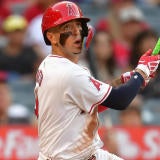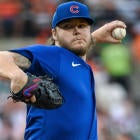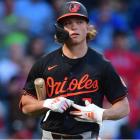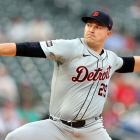
Bryce Miller is off to a heck of a start to his MLB career. Through his first nine starts, he's sporting a 3.68 ERA, and even that probably understates how good he's been – he has seven quality starts, including six with six innings and one or zero runs allowed.
Outside of two rough outings against the Yankees and Rangers, Miller has pitched like an ace. And, he already showed the ability to bounce back from those two rough starts, following up 15 earned runs in seven innings by limiting the Marlins and White Sox to two runs while striking out 12 over his past two outings.
It all sounds like an incredibly talented young pitcher, a top-100 prospect prior to his debut, simply living up to the hype. But it's not quite so simple, because Miller is thriving in a way very, very few major-league pitchers have been able to do in recent years. And that makes me question how sustainable his success is moving forward.
Because Miller is, right now, pretty much just a one-pitch pitcher. I don't mean that he literally only throws one pitch, though he does lead the majors in four-seam fastball usage, at 68%. In the five seasons prior to 2023, no pitcher has qualified for the ERA title while throwing a four-seam fastball more than 62.3% of the time. Only four have topped a 60% usage rate for a four-seam fastball while qualifying for the ERA title, and again, Miller is throwing his 68% of the time.
Of course, if you click through that link you'll notice Carlos Rodon in 2022 and Justin Verlander in 2018 as two of those pitchers, which is pretty good company to keep; Rodon finished sixth in the NL Cy Young vote last season, while Verlander was the runner-up in 2018 in the AL. However, what separates Miller from those two and some of the other high fastball usage aces is that, at least right now, the fastball is kind of all he has going for him.
In 2022, Rodon threw his slider 31% of the time and had a 39% whiff rate with the pitch; Verlander threw his slider 22% of the time with a 39% whiff rate, while his curveball had a 34% whiff rate at a 15% usage rate. Miller's No. 2 pitch has been his slider, with a 17% usage rate and 11.4% whiff rate. Among pitchers who have ended at least 10 PA with a slider, per BaseballSavant.com, Miller's whiff rate ranks fourth from the bottom right now.
Compare that to the five other most fastball-dependent starters and their best secondary pitch, and you can see Miller is a clear outlier:
- Miller (68% fastball usage): 11% whiff rate on slider, 19% whiff rate on sweeper
- Michael Kopech (63% fastball usage): 26% whiff rate on slider
- Justin Steele (62% fastball usage): 30% whiff rate with slider
- Mackenzie Gore (60% fastball usage): 46% whiff rate on curveball, 40% whiff rate on slider
- Cristian Javier (59% fastball usage): 31% whiff rate on slider
- Spencer Strider (59% fastball usage): 56% whiff rate on slider
Miller is a clear outlier in terms of both his fastball usage and his ability to get whiffs with his other pitches. The fastball is, to be clear, a very, very good pitch. In the Stuff+ model on FanGraphs, it rates as the fourth-best four-seamer in the game, and when you account for location, it jumps up to fourth. He generates a ton of spin with the pitch and consistently pumps it up into the high-90s, and that combined with his arm angle helps the pitch create the fifth-most rise among all four-seam fastballs.
A rising fastball is a good fastball, generally speaking. Rising fastballs help you miss barrels, leading to weak pop ups when batters make contact, but most importantly they tend to lead to a good amount of missed bats. Miller's four-seamer is in the 90th percentile among that pitch type in expected wOBA allowed (.282), and while his 67th percentile whiff rate isn't quite elite, it's still clearly very good.
That four-seamer is clearly a very good pitch. But is it enough? That's where my questions come in. The idea that starting pitchers need deep repertoires to thrive when batters see them multiple times in a game has been challenged in recent years by the likes of Strider and Javier, but again, those guys also come armed with clearly very good secondary pitches.
Miller's slider certainly isn't a disaster, despite the low whiff rate. His expected wOBA allowed on the pitch is .274, in the 55th percentile for sliders this season, so batters are struggling to do much with it even if they're making a lot of contact against it. And, that Stuff+ model rates the pitch 33rd out of 100 qualifiers, so, at least based on movement, velocity, spin, and other physical characteristics of the pitch, it looks like it's at least got some potential.
Which is to say that, while Miller might be best described right now as a "one-pitch pitcher," that doesn't necessarily mean he'll be one forever. The Mariners have shown a willingness to let their young starters tinker and experiment, and it's led to Logan Gilbert developing what looks like a very good splitter this season, to name one high-profile example. Miller has a good base with that fastball, and if even one of his secondaries takes a step forward (he'll occasionally mix in a changeup and curveball in addition to the slider and sweeper), that could be enough to help him sustain this current run.
And we're still dealing with very small samples all around here – he's thrown 132 sliders total, for example. Sometimes, weird things happen in small samples, and Miller's slider might be better than he's shown so far. He might also just need to tweak some things to get the most out of it; right now, Miller's average vertical release point on the slider and sweeper is about four inches lower than his fastball, which might be telegraphing the pitch to hitters:

He's also not throwing the ball to parts of the strike zone that figure to be conducive to swings and misses, which could be a relatively simple fix. Dropping his in-zone rate on his slider from 56% (92nd percentile) could be one way Miller could make that a better swing-and-miss pitch:
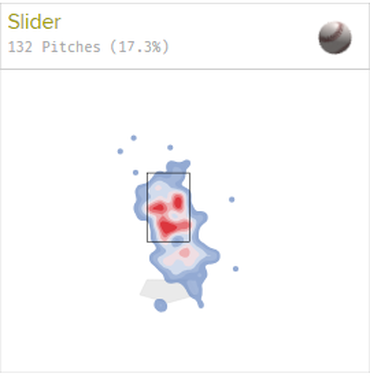
Miller looks the part of a polished, finished product in a lot of ways – he has a clear plan of attack for batters, he executes it consistently, and he rarely struggles with control, sporting an elite 4.0% walk rate. But his early success might hide that he's still learning on the job. That he's managing to succeed in spite of that is a testament to his prodigious skills and that terrific fastball.
But there's no shortage of pitchers who have looked like they belong early on, only to find they don't have a second gear when hitters adjust to their early success. And I'm worried Miller's limited-at-present approach is going to leave him prone to struggles when opposing hitters make their adjustments.
He might just be an outlier, but Fantasy players generally shouldn't be in the business of betting on outliers. Miller looks to my eyes like a pretty clear sell-high candidate right now. That's not to say he can't succeed, either with his current approach or by making strides with his non-fastball pitches. But, right now, I'm inclined to be skeptical. There's obvious upside here, but I think there will be more struggles coming, and I'd be looking to move Miller for someone like Tyler Glasnow or Pablo Lopez, who I have a lot more faith in moving forward.




